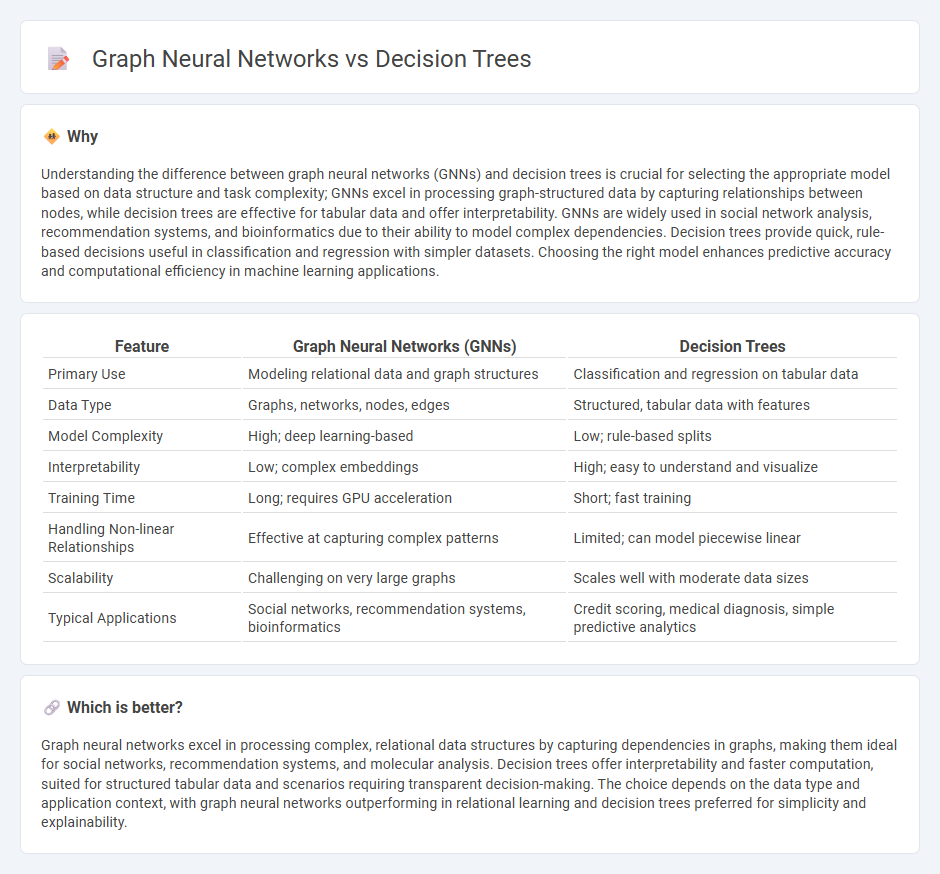
Graph Neural Networks excel at capturing complex relationships and structures within graph-structured data, enabling advanced applications in social networks, recommendation systems, and biological networks. Decision Trees offer interpretable, rule-based classification and regression models suited for tabular data with straightforward decision paths. Explore deeper insights on the strengths and use cases of Graph Neural Networks versus Decision Trees.
Why it is important
Understanding the difference between graph neural networks (GNNs) and decision trees is crucial for selecting the appropriate model based on data structure and task complexity; GNNs excel in processing graph-structured data by capturing relationships between nodes, while decision trees are effective for tabular data and offer interpretability. GNNs are widely used in social network analysis, recommendation systems, and bioinformatics due to their ability to model complex dependencies. Decision trees provide quick, rule-based decisions useful in classification and regression with simpler datasets. Choosing the right model enhances predictive accuracy and computational efficiency in machine learning applications.
Comparison Table
| Feature | Graph Neural Networks (GNNs) | Decision Trees |
|---|---|---|
| Primary Use | Modeling relational data and graph structures | Classification and regression on tabular data |
| Data Type | Graphs, networks, nodes, edges | Structured, tabular data with features |
| Model Complexity | High; deep learning-based | Low; rule-based splits |
| Interpretability | Low; complex embeddings | High; easy to understand and visualize |
| Training Time | Long; requires GPU acceleration | Short; fast training |
| Handling Non-linear Relationships | Effective at capturing complex patterns | Limited; can model piecewise linear |
| Scalability | Challenging on very large graphs | Scales well with moderate data sizes |
| Typical Applications | Social networks, recommendation systems, bioinformatics | Credit scoring, medical diagnosis, simple predictive analytics |
Which is better?
Graph neural networks excel in processing complex, relational data structures by capturing dependencies in graphs, making them ideal for social networks, recommendation systems, and molecular analysis. Decision trees offer interpretability and faster computation, suited for structured tabular data and scenarios requiring transparent decision-making. The choice depends on the data type and application context, with graph neural networks outperforming in relational learning and decision trees preferred for simplicity and explainability.
Connection
Graph neural networks (GNNs) and decision trees both serve as powerful tools in machine learning for structured data analysis, where GNNs excel in learning relationships within graph-structured datasets and decision trees effectively handle hierarchical feature-based splits. Hybrid models integrating GNNs with decision tree algorithms enhance interpretability and predictive accuracy by leveraging GNNs' ability to encode topological information alongside decision trees' straightforward rule extraction. Understanding their connection enables advancements in applications such as bioinformatics, social network analysis, and recommendation systems.
Key Terms
Structure (Hierarchical vs. Graph-based)
Decision Trees utilize a hierarchical, tree-structured model that splits data based on feature values, enabling clear interpretability and straightforward decision paths. Graph Neural Networks (GNNs) leverage graph-based structures to capture complex relationships and interactions among nodes, enabling learning from non-Euclidean data like social networks or molecular graphs. Explore the nuances of these models to understand their applications and advantages in various machine learning tasks.
Interpretability
Decision Trees provide high interpretability through clear, rule-based structures that allow users to trace decision paths easily. Graph Neural Networks (GNNs) offer powerful representation learning for complex graph data but often lack transparency due to their deep and distributed architecture. Explore how each model balances interpretability and performance in your specific applications for deeper insights.
Node Representation
Decision Trees classify nodes through hierarchical feature splits, making decisions based on attribute thresholds without leveraging node connectivity or neighborhood information. Graph Neural Networks (GNNs) generate node embeddings by aggregating features from neighboring nodes, effectively capturing complex relational patterns and graph topology for enhanced node representation learning. Explore how GNNs outperform traditional decision trees in node representation to optimize graph-based tasks.
Source and External Links
Decision Trees - IBM - A decision tree is a non-parametric supervised learning algorithm used for both classification and regression tasks, structured as a hierarchical tree with a root node, internal nodes, and leaf nodes.
Decision Tree - GeeksforGeeks - Decision trees are used in machine learning to make decisions by mapping out choices and outcomes, primarily categorized into classification and regression trees.
Decision Tree - Wikipedia - A decision tree is a flowchart-like structure that uses a tree-like model to represent decisions and their consequences, often used in decision analysis and operations research.
 dowidth.com
dowidth.com